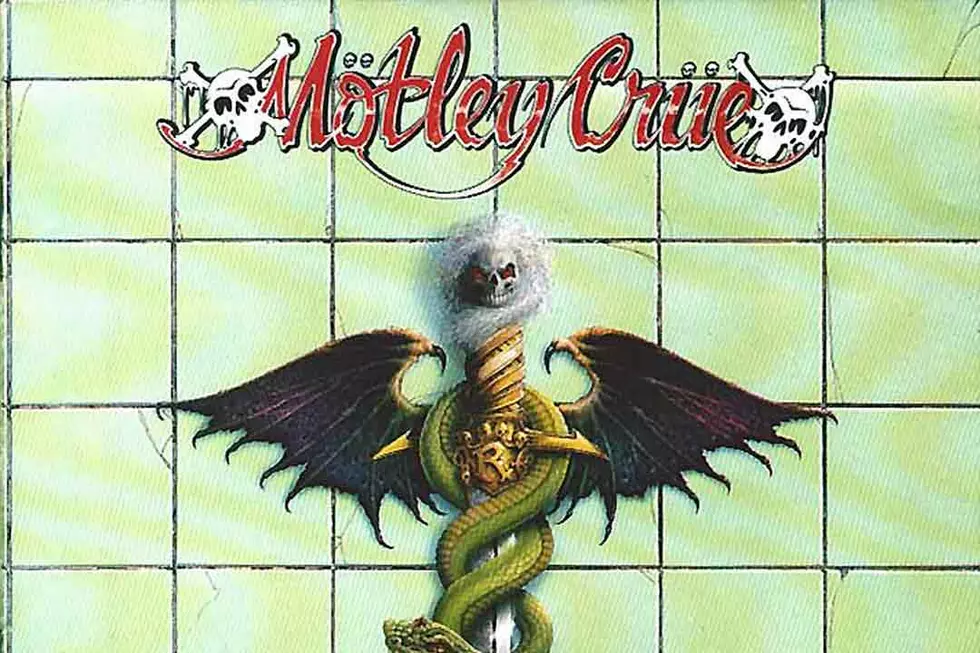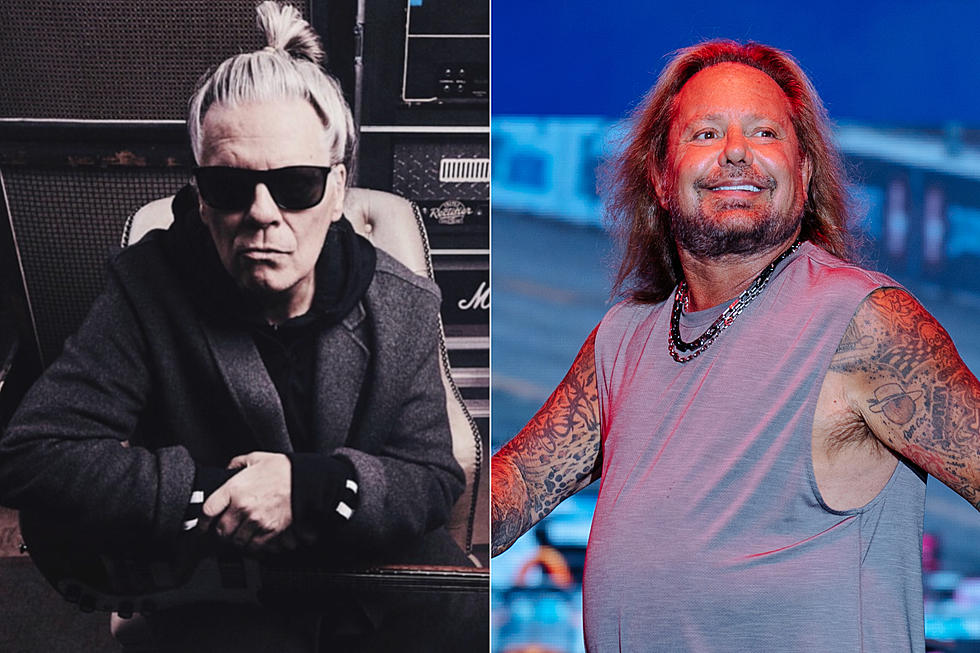
How Motley Crue Hit a New Peak With ‘Dr. Feelgood’
Motley Crue released their fourth studio LP, Girls, Girls, Girls, in the summer of 1987, adding another multi-platinum hit to their growing list. But as the band's popularity grew, so did its members' propensity for self-destructive behavior – none more so than bassist and main songwriter Nikki Sixx, whose worsening drug problem nearly destroyed the group just as it was hitting its stride.
In late 1987, Sixx was declared dead after a heroin overdose. Initially, he tried to shrug it off, bolting from the hospital after being revived by paramedics; as he later wrote in the memoir inspired by his addiction battle, The Heroin Diaries, "There was a cop asking me questions, so I told him to go fuck himself. I ripped out my tubes and staggered in just my leather pants into the parking lot, where two teenage girls were sitting crying around a candle. They had heard on the radio that I was dead and looked kind of surprised to see me."
The experience ultimately proved to be a turning point, however – not just for Sixx, but for the entire band. Ordered by their management team to clean up their act, Crue members Vince Neil, Tommy Lee and Mick Mars all joined Sixx in drying out. Newly sober, the quartet convened to start work on their fifth album with a level of focus and commitment they'd never really bothered to bring to bear on previous efforts.
"We all took a break from a lot of crazy shit," explained Lee during an interview for the record's 20th anniversary. "Everybody was sort of at their peak – you know, like drugs and alcohol – and we basically moved to Vancouver to embark on this amazing new record with everybody feeling good and focused. It was a really good time."
But the meaning of "good time" had changed in the context of Motley Crue. Where before it may have meant a lot of partying in the studio, the group was under a new regime in Vancouver: producer Bob Rock, whose ruthless commitment to the music put the band under a level of scrutiny it had never experienced.
"For once the studio wasn't a place to party and bring chicks, it was a place to work. And work it was," recalled Sixx in the band bio The Dirt. "Bob whipped us like galley slaves. His line was, 'That just isn't your best.' Nothing was good enough. Mick recorded all the guitar for Shout at the Devil in two weeks, but now Bob Rock would make him spend two weeks doubling a guitar part over and over until it was perfectly synchronized. And even though the process aggravated and frustrated Mick, he had it much easier than Vince, who on some days would only get a single word on tape that Bob liked."
Even while they were pushed to their musical limits, however, the band members understood the need for a change. Sixx explained the do-or-die atmosphere surrounding the record in a separate interview, saying: "We all said, 'Look, we either have to get it together and become the biggest band in the world, or we're going to knock this thing on the head and go out with more fury than anyone has ever hit the music business with.'"
Under pressure to deliver and unable to blowing off steam like they used to, the band members found life under Rock's watch disorienting. "Six months of rigor combined with six months of sobriety tore the life out of us, and we all had to put up with each other's violent and sudden mood swings," Sixx said. "Before we walked into the studio each day, we never knew whether we'd leave that evening feeling like the best band in the world or four angry clowns who couldn't even play their instruments."
They were able to draw some small comfort, however, in the knowledge that they were far from the only rock stars looking to make a life change. "Aerosmith was recording Pump in the studio next to us and meeting with the same counselor we were using," Sixx added. "After work we'd do the kinds of ridiculous things that sober rock stars do together, like drink Perrier or jog around a lake."
Watch Motley Crue's 'Dr. Feelgood' Video
However difficult the sessions might have been, the ends justified the means. Rock's decision to record the group's parts separately helped create a tighter, cleaner sound than they'd previously been able to achieve, and the new songs were among Crue's finest – an evolution fans eagerly embraced after the completed album, titled Dr. Feelgood, arrived in stores on Sept. 1, 1989.
By mid-October, the record had topped the album charts, giving Motley Crue their first No. 1 LP and beginning an incredible streak of success that would grow to include five rock radio hits, four Top 40 singles and millions of copies of Dr. Feelgood sold. The fun all started with the album's title track and first single, which peaked at an impressive No. 6 on the pop charts – a new high for the band.
"I knew it was a classic from the time I heard that very first 'bomp bomp bomp bomp' – that intro just kind of grabs you," Vince Neil later told Rolling Stone. "This song has been popular for 20 years. It was funny because I was watching VH1 and they had the Greatest Hard Rock Songs and 'Feelgood' was 15 or something. I was like, 'Wow, of all time.' Then you have Led Zeppelin and Aerosmith and AC/DC and 'Feelgood.' I was like, 'Wow, that's cool.' It's our signature song in some ways."
The "Feelgood" run continued with the No. 27 "Kickstart My Heart," inspired by Sixx's 1987 overdose, and the No. 8 power ballad "Without You," followed in the summer of 1990 by "Don't Go Away Mad (Just Go Away)" (No. 19). The record finally started running out of Top 40 steam with its fifth single, "Same Ol' Situation (S.O.S.)," which rose no further than No. 78 on the pop charts while squeaking into the Top 40 at rock radio.
But if the number of potential hits from the record was obviously finite, demand for the band's music seemed endless – to the point that the months following the release of Dr. Feelgood found them confined to a grueling tour schedule that sent them hurtling toward burnout.
"For our whole lives, every one of us had fucking fantasized about being exactly where we were on that tour, but after two years, we came to hate and dread our jobs. Nikki liked to compare it to an erection: It feels great for a few minutes, but when it won't go down after hours ... it starts to hurt like no other pain known to man," explained Lee in The Dirt, looking back on the end of the tour by adding, "Dude, you've never seen four motherfuckers split up and go their own way faster than we did."
Unfortunately for the band's fans, once they split up, it would prove incredibly difficult to put them back together. They released a placeholder hits collection, Decade of Decadence, in the fall of 1991, and the three new songs tacked onto the compilation ended up being the last songs Neil would record as the lead singer of Motley Crue before unceremoniously departing the lineup in February 1992.
Neil eventually returned in 1997, after the band recorded a self-titled effort with replacement singer John Corabi). Still, the momentum they'd worked so hard to build over those first 10 years was broken, and Motley Crue never returned to the commercial heights they scaled with Dr. Feelgood.
Top 50 Classic Heavy Metal Albums
Think You Know Motley Crue?
More From Ultimate Classic Rock









